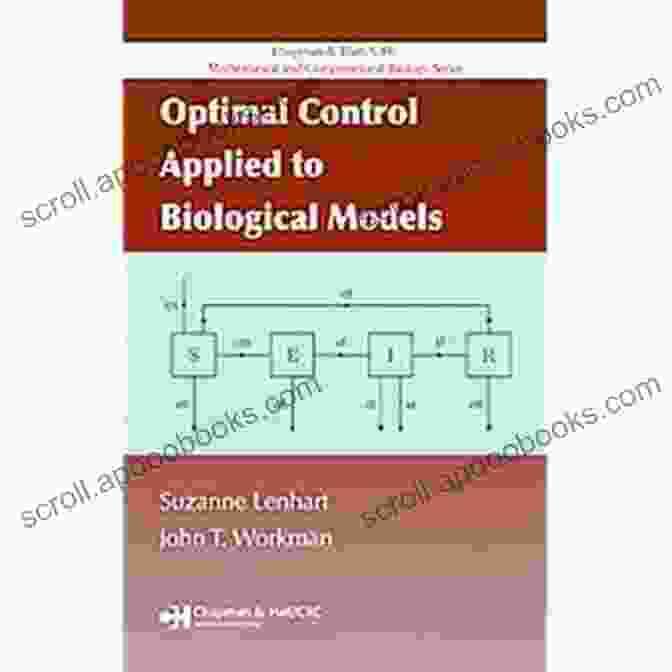Optimal Control Applied to Biological Models: Unlocking the Potential of Biology with Mathematical Precision

Biology, a captivating field that explores the intricate workings of living organisms, has long been intertwined with mathematics, a powerful tool that provides the language to quantify and analyze biological phenomena. Among the myriad applications of mathematics in biology, optimal control stands out as a sophisticated technique that allows scientists to optimize biological systems and guide their behavior towards desired outcomes.

5 out of 5
| Language | : | English |
| File size | : | 1922 KB |
| Text-to-Speech | : | Enabled |
| Enhanced typesetting | : | Enabled |
| Word Wise | : | Enabled |
| Print length | : | 212 pages |
| Screen Reader | : | Supported |
| Hardcover | : | 274 pages |
| Item Weight | : | 1.15 pounds |
| Dimensions | : | 6.14 x 0.63 x 9.21 inches |
Optimal control is a branch of mathematics concerned with finding the best way to control a system over time, often with the goal of maximizing or minimizing a certain objective. When applied to biological systems, optimal control enables researchers to identify optimal strategies for controlling biological processes, such as population growth, drug delivery, or cancer treatment.
This comprehensive article delves into the fascinating world of optimal control applied to biological models, exploring its history, applications, and the transformative insights it has brought to the study of life itself.
A Journey Through Time: The Evolution of Optimal Control in Biology
The roots of optimal control can be traced back to the early 20th century, when mathematicians began developing techniques for optimizing industrial processes and engineering systems. In the 1960s and 1970s, biologists recognized the potential of optimal control for understanding and controlling biological systems, and the field began to flourish.
One of the pioneers in this area was Robert May, an ecologist who used optimal control to study population dynamics. May's work demonstrated that optimal control could provide valuable insights into the factors that influence population growth and stability, and laid the foundation for the application of optimal control to other areas of biology.
Applications: Where Optimal Control Shines in Biology
The applications of optimal control in biology are far-reaching, spanning a diverse range of biological systems and phenomena. Some of the most notable applications include:
- Population Dynamics: Optimal control has been used to study population growth, extinction, and the dynamics of interacting species. It has provided insights into the optimal harvesting strategies for sustainable resource management and the design of conservation measures to protect endangered species.
- Epidemiology: In the field of epidemiology, optimal control has been instrumental in modeling the spread of infectious diseases and evaluating the effectiveness of control measures such as vaccination and quarantine. It has played a pivotal role in guiding public health policies and mitigating the impact of epidemics.
- Evolutionary Dynamics: Optimal control has been applied to study the evolution of biological traits, such as body size, lifespan, and reproductive strategies. It has helped researchers understand the selective pressures that shape the evolution of species and the dynamics of adaptive radiation.
- Drug Delivery: Optimal control has been used to optimize drug delivery systems, ensuring that drugs reach their target sites in the body with the desired dose and timing. It has led to the development of more effective and targeted drug therapies for a variety of diseases, including cancer and cardiovascular diseases.
- Cancer Treatment: In the fight against cancer, optimal control has been applied to optimize treatment strategies, such as chemotherapy and radiotherapy. It has helped identify optimal treatment schedules and dose regimens that maximize tumor reduction while minimizing side effects, leading to improved patient outcomes.
Benefits: Unveiling the Transformative Power of Optimal Control
The application of optimal control to biological models has brought about a wealth of benefits, revolutionizing the way scientists study and manipulate biological systems. Some of the key benefits include:
- System Optimization: Optimal control provides a systematic approach for optimizing biological systems, identifying the best strategies for achieving desired outcomes, such as maximizing population growth, minimizing disease transmission, or enhancing drug efficacy.
- Predictive Modeling: Optimal control models allow researchers to predict the behavior of biological systems under different conditions and control strategies. This predictive power enables scientists to anticipate future outcomes and make informed decisions about how to manage and manipulate biological systems.
- Enhanced Understanding: By constructing and analyzing optimal control models, researchers gain a deeper understanding of the underlying mechanisms and dynamics of biological systems. This enhanced understanding facilitates the development of more effective and targeted interventions and therapies.
Challenges and the Road Ahead
Despite its remarkable success, optimal control applied to biological models is not without its challenges. One challenge lies in the complexity of biological systems, which can make it difficult to develop accurate and tractable models. Another challenge is the computational complexity of optimal control algorithms, which can limit their applicability to large-scale systems.
Ongoing research is addressing these challenges, focusing on developing more efficient and robust optimal control algorithms and refining models to better capture the intricate complexities of biological systems. As these challenges are overcome, the future of optimal control in biology holds immense promise for advancing our understanding and control of life itself.
Optimal control applied to biological models has emerged as a powerful tool that enables scientists to optimize biological systems, predict their behavior, and gain a deeper understanding of their underlying mechanisms. From population dynamics to cancer treatment, optimal control has revolutionized the way we study and manipulate biological systems, leading to groundbreaking discoveries and improved outcomes.
As the field continues to evolve, we can anticipate even more transformative applications of optimal control in biology, empowering us to harness the full potential of life sciences and address some of the most pressing challenges facing humanity.
5 out of 5
| Language | : | English |
| File size | : | 1922 KB |
| Text-to-Speech | : | Enabled |
| Enhanced typesetting | : | Enabled |
| Word Wise | : | Enabled |
| Print length | : | 212 pages |
| Screen Reader | : | Supported |
| Hardcover | : | 274 pages |
| Item Weight | : | 1.15 pounds |
| Dimensions | : | 6.14 x 0.63 x 9.21 inches |
Do you want to contribute by writing guest posts on this blog?
Please contact us and send us a resume of previous articles that you have written.
 Book
Book Novel
Novel Page
Page Chapter
Chapter Text
Text Story
Story Genre
Genre Reader
Reader Library
Library Paperback
Paperback E-book
E-book Magazine
Magazine Newspaper
Newspaper Paragraph
Paragraph Sentence
Sentence Bookmark
Bookmark Shelf
Shelf Glossary
Glossary Bibliography
Bibliography Foreword
Foreword Preface
Preface Synopsis
Synopsis Annotation
Annotation Footnote
Footnote Manuscript
Manuscript Scroll
Scroll Codex
Codex Tome
Tome Bestseller
Bestseller Classics
Classics Library card
Library card Narrative
Narrative Biography
Biography Autobiography
Autobiography Memoir
Memoir Reference
Reference Encyclopedia
Encyclopedia Brigit Anna Mcneill
Brigit Anna Mcneill Mark Doty
Mark Doty Winston Groom
Winston Groom Bobbie Jo Hart
Bobbie Jo Hart Beverly Sade
Beverly Sade Paulo Cezar Da Rosa
Paulo Cezar Da Rosa William Norman Grigg
William Norman Grigg Timothy Stephany
Timothy Stephany Uwe Fritz
Uwe Fritz Bob Bearden
Bob Bearden James Naughton
James Naughton Greg Smalley
Greg Smalley Brandon Salo
Brandon Salo Bill Peterson
Bill Peterson Bridget E Baker
Bridget E Baker Brian House
Brian House Blake Stevens
Blake Stevens Blkcm Bnkcm
Blkcm Bnkcm Brian Mccord
Brian Mccord Brendan Bruce
Brendan Bruce
Light bulbAdvertise smarter! Our strategic ad space ensures maximum exposure. Reserve your spot today!

 Ivan TurgenevSocial Media Is Ruining Romance: An In-Depth Look at the Damaging Effects of...
Ivan TurgenevSocial Media Is Ruining Romance: An In-Depth Look at the Damaging Effects of... Jack ButlerFollow ·3.1k
Jack ButlerFollow ·3.1k Dakota PowellFollow ·9.8k
Dakota PowellFollow ·9.8k Derrick HughesFollow ·19k
Derrick HughesFollow ·19k Mario BenedettiFollow ·19.4k
Mario BenedettiFollow ·19.4k Mark TwainFollow ·12.6k
Mark TwainFollow ·12.6k Jake PowellFollow ·10.4k
Jake PowellFollow ·10.4k Robbie CarterFollow ·11.3k
Robbie CarterFollow ·11.3k Ira CoxFollow ·2.3k
Ira CoxFollow ·2.3k

 Corey Green
Corey GreenHuman Geography: A Concise Introduction by Gilbert...
A Journey into the Dynamic Realm of...

 Julian Powell
Julian PowellTrain Your Mind to Make Great Art a Habit
Do you dream of...

 Matthew Ward
Matthew WardSmall Town Romance: Heart Compass
Escape to Willow Creek, Where...

 Neil Parker
Neil ParkerMusic, Social Media, and Global Mobility: Exploring...
: The Convergence of Music, Media, and...

 Seth Hayes
Seth HayesUnlock the Potential of Potential Theory with Brooke...
Embark on an...
5 out of 5
| Language | : | English |
| File size | : | 1922 KB |
| Text-to-Speech | : | Enabled |
| Enhanced typesetting | : | Enabled |
| Word Wise | : | Enabled |
| Print length | : | 212 pages |
| Screen Reader | : | Supported |
| Hardcover | : | 274 pages |
| Item Weight | : | 1.15 pounds |
| Dimensions | : | 6.14 x 0.63 x 9.21 inches |












